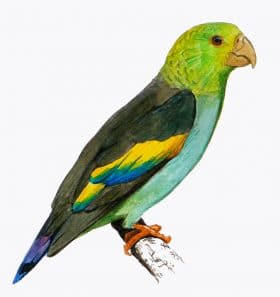Content |
|---|
Description:
The Lilac-tailed Parrotlet (Touit batavicus) has 14 cm.. height. Usually black in it upperparts (back and wings) and green in it lower. With the crown and nape yellowish-green with black border (What gives a suspiciously aspect). The forecrown, cheeks and chin Yellow Gold, chest Azure Blue, Yellow patch in the wing , tail ends reddish purple and black subterminal edge.
- Sound of the Lilac-tailed Parrotlet .
Habitat:
It inhabits in forest dry and jungles cloudy between 400 and 1700 m (in Colombia).
Considered powerful flying, the sharp profile of its wings, They quickly fly over the forest canopy, in groups of 10 to 50 and they are gregarious except in the time reproductive.
It is of a forest Ave, but it can be seen near the shore of the sea in the areas where the edge of the forest close to the coast.
The calls during the flight they are soft and nasal, reaching a high tone, Buzz.
Reproduction:
It nests in hollows in trees or in arboreal termite holes, between the months of February and March. It is thought that it has migratory movements.
Food:
Its diet is composed of flowers, nectar, fruit, outbreaks, berries and seeds.
Distribution:
Size of the area of distribution (reproduction / resident): 330.000 km2
Can be found from the North of Venezuela According to the East up to Guyana, Suriname, French Guiana and in Trinidad and Tobago.
Conservation:
State of conservation ⓘ |
||
|---|---|---|
 Minor Concern ⓘ
(UICN)ⓘ
Minor Concern ⓘ
(UICN)ⓘ
| ||
• Current category of the Red List of the UICN: Least concern.
• Population trend: Decreasing.
Justification of the population
The size of the world population It has not been quantified, but this species is described as “quite common” (Stotz et to the., 1996).
Justification of trend
They suspect that this species has lost a 8,2-8,4% of habitat suitable within their distribution during three generations (15 years) based on a model of Amazon deforestation (Soares-Filho et to the., 2006, Bird et to the., 2011). Given the susceptibility of the species to the hunting or the capture, It is suspected that will decrease in <25% during three generations.
"Lilac-tailed Parrotlet " in captivity:
It's hard to keep alive captivity, refuses food during the acclimatization period. Deaths occur for this reason and the unbalanced diet.
Images of the "Lilac-tailed Parrotlet "
Videos:
Alternative names:
– Lilac-tailed Parrotlet, Black-winged Parrot, Lilac tailed Parrotlet, Scopoli’s Parrot, Seven-colored Parrot, Seven-colored Parrotlet, Seven-coloured Parrot, Seven-coloured Parrotlet (English).
– Toui à sept couleurs (French).
– Siebenfarbenpapagei, Siebenfarben-Papagei (German).
– Lilac-tailed Parrotlet (Portuguese).
– Cotorrita Sietecolores, Lorito de Siete Colores (español).
scientific classification:

– Order: Psittaciformes
– Family: Psittacidae
– Genus: Touit
– Scientific name: Touit batavicus
– Citation: (Boddaert, 1783)
– Protonimo: Psittaca Batavica
Lilac-tailed Parrotlet (Touit batavicus)
Sources:
- Avibase
- Parrots of the World – Forshaw Joseph M
- Parrots A Guide to the Parrots of the World – Tony Juniper & Mike Parr
- Parrot Book, Parrots and macaws Neotropical
Photos:
(1) – birdsoftt
(2) – Lilac-tailed Parrotlet. Watercolor, Romain Risso By Gossipguy (Own work) [CC BY-SA 3.0], via Wikimedia Commons



Tthe LIFE OF THEM IS FREEDOM IN NATURE, DO NOT JAIL taking them out of their environment.
I WOULD LIKE TO BUY SOME VARIETIES OF BIRDS INCLUDING MACAWS WOULD BE AND OTHERS